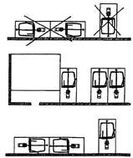(add external link) |
No edit summary |
||
| Line 28: | Line 28: | ||
[http://www.ehow.com/how_3255_rid-home-mice.html How to Rid Your Home of Mice]if your home has garden, you'd better visit it. |
[http://www.ehow.com/how_3255_rid-home-mice.html How to Rid Your Home of Mice]if your home has garden, you'd better visit it. |
||
| + | [http://www.wildlife.pro/orlando-rat-control.html Pest Control Solutions for Mouse & Rat Problems in the Attic] |
||
Revision as of 04:10, 4 December 2006
The house mouse (Mus musculus) is considered one of the most troublesome and economically important pests in the United States. House mice live and thrive under a variety of conditions in and around homes and farms. House mice consume food meant for humans or pets. They contaminate food-preparation surfaces with their feces, which can contain the bacterium that causes food poisoning (salmonellosis). Their constant gnawing causes damage to structures and property.
Recognizing Mouse Infestations
Droppings, fresh gnawing and tracks indicate areas where mice are active. Mouse nests, made from fine shredded paper or other fibrous material, are often found in sheltered locations. House mice have a characteristic musky odor that identifies their presence. Mice are occasionally seen during daylight hours.
Trap
Trap. Trapping is an effective control method. When only a few mice are present in a building, it is usually the preferred control method. Trapping has several advantages:
(1) it does not rely on inherently hazardous poisons
(2) it permits the user to make sure that the mouse has been killed
(3) it allows for disposal of the mouse carcasses, thereby avoiding dead mouse odors that may occur when poisoning is done within buildings.

How to locate the traps correctly
The simple, inexpensive wood-based snap trap is effective and can be purchased in most hardware and grocery stores. Bait traps with peanut butter, chocolate candy, dried fruit or a small piece of bacon tied securely to the trigger. Set them so that the trigger is sensitive and will spring easily.
Multiple-capture live traps, which can capture several mice once set, are also available in some hardware and feed stores. Set traps close to walls, behind objects, in dark corners and in places where evidence of mouse activity is seen. Place them so that mice will pass directly over the triggers as they follow the natural course of travel, usually close to a wall. Traps can be set on ledges or on top of pallets of stored materials if mice are active in such locations. Use enough traps to eliminate the rodents quickly. (Using too few traps is a common error by individuals attempting to control mice.) Mice seldom venture far from their shelter and food supply, so place traps no more than 10 feet apart in areas where mice are active. Leaving traps unset until the bait has been taken at least once (prebaiting) often increases the success of trapping.
Glue board
An alternative to traps are glue boards, which catch and hold mice attempting to cross them in much the same way flypaper catches flies. Place glue boards along walls where mice travel. Two or three glue boards placed side-by-side (or the larger glue boards used for rats) will be more effective than individual boards. Do not use them where children, pets or desirable wildlife can contact them. Glue boards can be placed inside tamper-resistant bait boxes in exposed locations. Glue boards lose their effectiveness in dusty areas unless covered and extremes of temperature also may affect the tackiness of the glue. Glue boards are sometimes used to catch a mouse that is wary of snap traps.
External links
How to Rid Your Home of Miceif your home has garden, you'd better visit it. Pest Control Solutions for Mouse & Rat Problems in the Attic